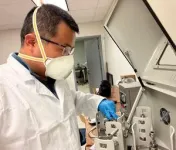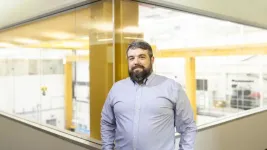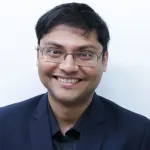(Press-News.org) UNIVERSITY PARK, Pa. — Rocks once buried deep in ancient subduction zones — where tectonic plates collide — could help scientists make better predictions of how these zones behave during the years between major earthquakes, according to a research team from Penn State and Brown University.
Clues from rock formations in Alaska and Japan allowed the scientists to develop a new model to predict the pressure solution activity in subduction zones, the researchers reported in the journal Science Advances. Sedimentary rocks comprise grains surrounded by water-containing pores. When rocks are squeezed together under great pressure, the grains dissolve at their boundaries into the water present in pores, forming pressure solution. This allows the rocks to deform, or change shape, influencing how the tectonic plates slide past each other.
“It’s like when you go ice skating — the blade on the surface ends up melting the ice, which allows you to glide along,” said corresponding author Donald Fisher, professor of geosciences at Penn State. “In rocks, what happens is quartz grains dissolve at stressed contacts and the dissolved material moves to cracks where it precipitates.”
The world’s most powerful earthquakes happen in subduction zones, where one tectonic plate slides beneath the other. When these plates become stuck together, stress builds in the crust of the Earth — like a rubber band being stretched. When enough stress builds up to overcome the friction holding the plates together — like a rubber band snapping — an earthquake occurs.
“We’ve shown that pressure solution is a fundamental process during the interseismic period in subduction zones,” Fisher said. “The occurrence of this pressure solution can really affect the amount of elastic strain that accumulates in different parts of the seismogenic zone.”
Pressure solution is difficult to explore in the laboratory because it typically occurs very slowly over thousands to millions of years, Fisher said. Speeding up the process in the lab requires higher temperatures, which produces other changes in rocks that impact the experiments.
The scientists instead turned to rocks that once experienced these tectonic pressures and were later brought to the surface by geological processes. The rocks show microscopic shears — or breaks caused by strain — that contain textures that provide evidence for pressure solution, the scientists said.
“This work allows us to test a flow law, or model, that describes the rate of pressure solution in ancient rocks that were once down at the plate boundary and have been exhumed to the surface,” Fisher said. “And we can apply this to active margins that are moving today.”
A previous study by another team of scientists linked stress the rocks experienced and strain rate — or how much they deformed. In the new work, Fisher and his colleague, Greg Hirth, professor at Brown University, created a more detailed model that considers factors like the rocks’ grain size and solubility, or how much of the rock material can dissolve into liquid.
“We were able to parameterize the solubility as a function of temperature and pressure, in a practical way that hadn’t been done before,” Fisher said. “So now we can plug in numbers — different grain sizes, different temperatures, different pressures and get the strain rate out of that.”
The results can help reveal where in the seismogenic layer — the range of depths at which most earthquakes occur — that strain is occurring.
The researchers applied their model to the Cascadia Subduction Zone, an active fault that runs from northern California to Canada and by major cities like Portland, Oregon, Seattle and Vancouver, British Columbia.
The temperature along the plate boundary and the amount of strain built up is well studied there, and the results of their model match crustal movements based on satellite observations, the scientists said.
“Cascadia is a great example because it’s late in the interseismic period — it’s been 300 years since the last major earthquake,” Fisher said. “We may experience one in our lifetime, which would be the biggest natural disaster that North America can anticipate in terms of the potential for shaking and resulting tsunami.”
The National Science Foundation supported this work.
END
Ancient rocks improve understanding of tectonic activity between earthquakes
2024-02-07
ELSE PRESS RELEASES FROM THIS DATE:
The Medical University of South Carolina will be one of four sites exploring the genetic basis of Parkinson’s disease in the Black community
2024-02-07
The Michael J. Fox Foundation for Parkinson’s Research has chosen MUSC as one of four sites for the Black and African American Connections to Parkinson’s Disease (BLAAC PD) research study, a part of the Global Parkinson’s Genetics Program.
BLAAC PD will explore the genetic basis of Parkinson’s disease (PD) in the Black community by genotyping more than 150,000 people worldwide, setting the stage for the development of targeted treatments. According to the Parkinson’s Foundation, approximately 36,265 people with ...
ORNL's Jason DeGraw named ASHRAE Fellow
2024-02-07
The American Society of Heating, Refrigeration and Air-Conditioning Engineers, or ASHRAE, selected Jason DeGraw, a researcher with the Department of Energy’s Oak Ridge National Laboratory, as one of 23 members elevated to Fellow during its 2024 winter conference.
A thermal-fluid scientist and mechanical engineer in the Thermal Energy Storage group, DeGraw was recognized for making substantial contributions in heating, ventilation, air-conditioning and refrigeration, and the built environment. He contributes education, research, engineering design and consultation, publications, presentations and mentoring to ASHRAE. At ORNL, DeGraw works with the Building Technologies ...
Sara Federico, MD, named director of the Solid Tumor Division at St. Jude Children’s Research Hospital
2024-02-07
(Memphis, Tenn. – February 7, 2024) St. Jude Children’s Research Hospital today announced Sara M. Federico, MD, has been named director of the institution’s Solid Tumor Division within the Department of Oncology. Federico is an internationally recognized leader in pediatric oncology whose contributions have defined the landscape of treatment for high-risk childhood solid tumors, such as neuroblastoma.
“Dr. Federico’s experience will pave the way for new discoveries that will help advance cure rates for patients with high-risk cancers by identifying, testing and optimizing novel therapeutic strategies,” said Julie R. ...
Cancer researcher Craig B. Thompson named 2024 Watanabe Prize winner
2024-02-07
INDIANAPOLIS – Pioneering cancer researcher Craig B. Thompson, MD, has been named the 2024 winner of the August M. Watanabe Prize in Translational Research.
Awarded by the Indiana University School of Medicine, the Watanabe Prize is one of the nation's largest and most prestigious awards recognizing individuals focused on shepherding scientific discoveries into new therapies for patients. The prize is awarded to a senior investigator who has made a significant contribution to the field of translational science.
Thompson is the former president and chief executive officer ...
Chapman scientists code ChatGPT to design new medicine
2024-02-07
Generative artificial intelligence platforms, from ChatGPT to Midjourney, grabbed headlines in 2023. But GenAI can do more than create collaged images and help write emails — it can also design new drugs to treat disease.
Today, scientists use advanced technology to design new synthetic drug compounds with the right properties and characteristics, also known as “de novo drug design.” However, current methods can be labor-, time-, and cost-intensive.
Inspired by ChatGPT’s popularity and wondering if this approach could speed up the drug design process, scientists in the Schmid ...
Erectile dysfunction drugs may be linked to reduced risk of Alzheimer’s disease
2024-02-07
EMBARGOED FOR RELEASE UNTIL 4 P.M. ET, WEDNESDAY, FEBRUARY 7, 2024
MINNEAPOLIS – The drugs used to treat erectile dysfunction may also be associated with a reduced risk of Alzheimer’s disease, according to a study published in the February 7, 2024, online issue of Neurology®, the medical journal of the American Academy of Neurology. The study does not prove that erectile dysfunction drugs reduce the risk of Alzheimer’s disease. It only shows an association.
Erectile dysfunction drugs, which work by dilating blood vessels to allow more blood ...
Q&A: Helping robots identify objects in cluttered spaces
2024-02-07
Imagine a coffee cup sitting on a table. Now, imagine a book partially obscuring the cup. As humans, we still know what the coffee cup is even though we can't see all of it. But a robot might be confused.
Robots in warehouses and even around our houses struggle to identify and pick up objects if they are too close together, or if a space is cluttered. This is because robots lack what psychologists call "object unity," or our ability to identify things even when we can't see all of them.
Researchers at the University of Washington ...
Evaluation of ruxolitinib, a Janus Kinase inhibitor, in multiple myeloma
2024-02-07
“[...] the results of the studies presented in this review will hopefully provide the impetus for conducting additional preclinical and clinical studies to evaluate RUX in the setting of MM as well as other types of cancer.”
BUFFALO, NY- February 7, 2024 – A new research perspective was published in Oncotarget's Volume 15 on February 5, 2024, entitled, “Preclinical and clinical evaluation of the Janus Kinase inhibitor ruxolitinib in multiple myeloma.”
In this new paper, researchers Ashley Del Dosso, Elizabeth Tadevosyan, and James ...
Blood thinners added to clot-busting medication did not improve stroke outcomes
2024-02-07
Research Highlights:
Although giving blood thinners along with clot-busting medication may help in treating heart attacks, it did not improve 90-day outcomes in people with clot-caused strokes.
Enrollment in a large clinical trial, which had been planned to include more than 1,200 patients with ischemic stroke (clot-caused stroke), was halted after an independent data and safety monitoring board found no indication of benefit among the first 500 patients.
The data analysis for the 500 enrolled participants found giving blood thinners along with clot-busting medication did not increase the risk of bleeding into the brain.
Embargoed ...
Reinforcing the diverse ways people access seafood can ensure healthy communities in the face of change
2024-02-07
(Santa Barbara, Calif.) — As climate change affects the oceans, coastal communities, particularly those at the front lines of ocean warming and sea level rise, are facing pressures that could threaten their access to aquatic foods.
“Climate change and other economic shocks are impacting how people access seafood, and typically households that are most reliant on seafood, such as those in Pacific Island countries, are most at risk,” said Jacob Eurich, a research associate at UC Santa Barbara’s Marine Science Institute, and a fisheries scientist at the Environmental Defense Fund. Which is why, he added, it is necessary to increase food system resilience in the area, ...








